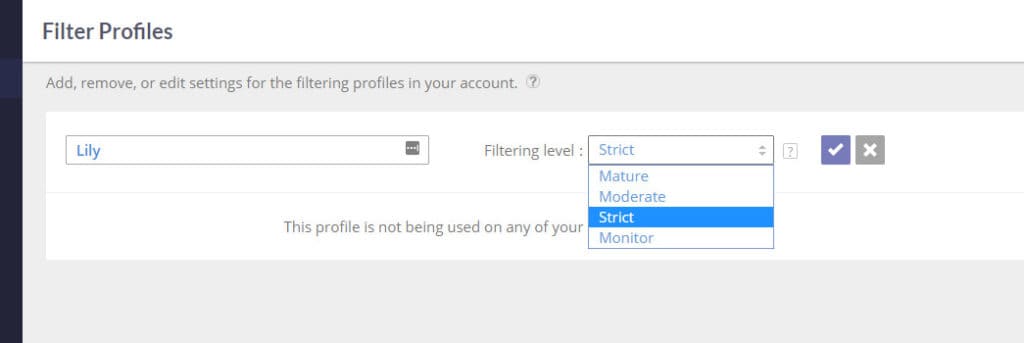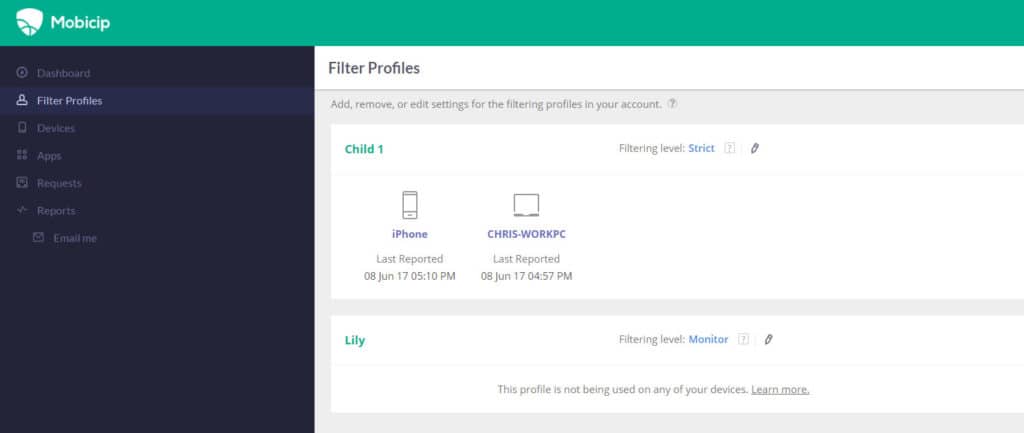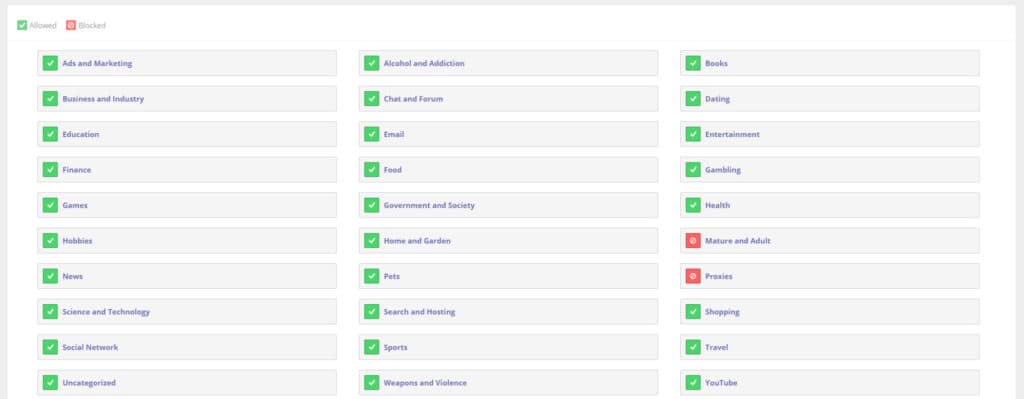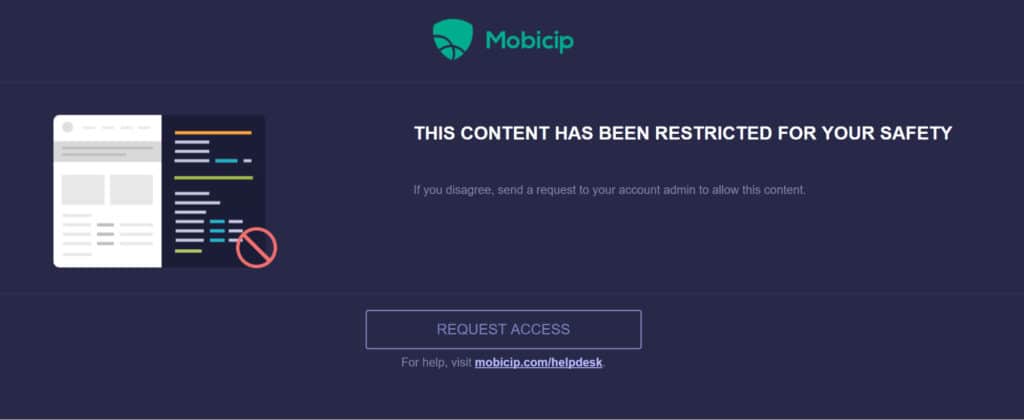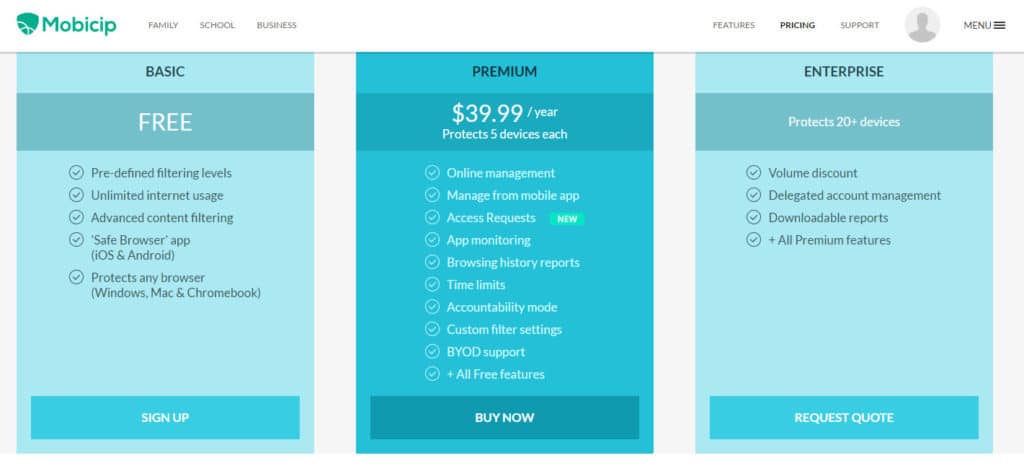
With both a free and a paid subscription model to offer parents, Mobicip is one of the more flexible, yet powerful options out there for any families who need to keep a closer eye on how their kids are behaving online. But nothing good comes for free…right?
Read on in our Mobicip parental control suite review to find out if this software measures up to the test!
Installation/Setup
Acquiring our subscription to Mobicip’s annual service could not have been any simpler, with about three clicks sitting between their front page and my first membership.
Getting Mobicip setup on the devices we wanted to use was a relatively straightforward process, with an installer on Windows handling the heavy lifting on PC/desktop, while a quick app download on iOS and Android got us running on the mobile side of things in a few minutes or less each.
To add a new device under the umbrella of protection you get with your Mobicip subscription, you need to install the software on the device you want to monitor and log in to your account online. Once you’ve logged in, you’ll be dropped in the main dashboard which contains everything you’ll need to get your family set up with the new system.
From here we then had to create Filter Profiles for each of the people we wanted to monitor, as well as associating those profiles with the devices the kids would be using. When you create a Filter Profile, you have four stock blocking options to choose from: Mature, Moderate, Strict, and Monitor.
The first three work similarly to most other parental control software, putting Mature right around the 16+ range, Moderate for kids 8-15, and Strict for anyone under that. Another option, however, is Monitor, which gives the profile complete access to any part of the web with the caveat that regardless of where they go, all their activity will be monitored.
Something I’d also like to note in this section is simply the sheer number of devices that Mobicip is compatible with, including: Windows, iOS, Mac OS, Android, Chromebook, Nook, and even the Kindle Fire. This is important because oftentimes the kids of the house aren’t always the ones with the most bleeding-edge devices. Coverage for lesser-known options like Chromebooks and Kindles is the perfect solution for anyone who bought their kid a budget beat-em-up device before they graduate to an iPhone or something similar.
Design and User Experience
Like most modern parental control suites, everything you do in Mobicip to manage your children’s online activity happens online in the browser of your choosing. From the online Mobicip dashboard you can create profiles for each of the children in your family, manage what they can see, and track any new online events that popped up during their day.
Mobicip also offers a separate mobile app from the main protection software, dubbed “Mobicip Monitor”, that acts as a mobile window into all your children’s activities.
The layout and overall design aesthetic of both the web browser application and the mobile offering are quite pleasing to the eye, and make sense while you’re navigating through settings or creating a new set of rules for another device in the house.
Everything was fluid and easy to understand. For any problems I did run into that might have left me scratching my head (of which there were very few), Mobicip made sure to include a small “?” icon next to each setting that linked to a FAQ page explaining everything it controls.
The mobile app on iOS is especially well designed. It was great for quickly taking a peek at any internet history on monitored machines while also giving a broad perspective of all the flags that had popped up during that day, week, or month. If the Mobicip Monitor app is installed on your mobile device, parents will immediately get notifications of what their kids are up to. These notifications are either sent to the phone or even straight to your Apple Watch.
Features
Mobicip’s parental control suite comes with a wide range of features, though some of them are only available through the premium subscription (more on that in the Pricing section below).
With a standard baseline premium subscription, you get the ability to monitor up to five devices at a time, each of which can have an infinite number of available profiles. Say you only have five devices in your home (two phones, two desktops/laptops and one tablet, for example), you will still be able to protect each one for as many children as you need thanks to the way the profile system works.
Each device can be monitored for web activity from the main dashboard, which keeps an eye on a number of different predetermined filtering parameters established in similar pieces of software. These include options like “Pornography” or “Alcohol”, but spread into pretty much any subject you can think of from there.
If you’d like to get more specific than that, you can enter domains or keywords into the blocker that will prevent any content containing those words from displaying on the protected devices.
Time scheduling is available for both the desktop version of the app and the mobile version, though parents should be aware that this will only control actual web browsing behavior on both Android and iOS, not text messaging or the use of any other apps.
Considering that Norton Family comes with an option to lockdown internet signal to the device entirely when the timer is up (at least in the case of Android), we would have liked to see some kind of similar option available here.
Mobile
It shouldn’t be a surprise by this point that the experience we had with the Mobicip mobile apps from iOS to Android were two very different experiences. As usual, the only level of actual control you’ll get from an iOS device (iPhone, iPad, etc), is to disable the native browser (Safari), as well as uninstalling any third-party browsers so the Mobicip browser is the only one left. While browsing on the Mobicip browser in iOS, all the child’s activity will still be monitored the same as it would on a Windows or Mac device.
And once again, as usual, the customization options on the Android side of things were far more extensive and allowed for a significantly higher level of control than what we saw on iOS. Here not only were you able to use the Mobicip browser to monitor their web activity, you could also see what apps they were installing, how long they spend on any given app, as well as the rating and review of that app in the app store.
The iOS version of the Mobicip app does have a small leg up over the competition competing apps like Norton Family Protection. Unlike those, Mobicip can also run the App Monitor service on iOS as long as you go through the extra setup steps necessary to get it working (they have a handy tutorial on the feature here). This will automatically update you whenever your child tries to add, modify, or delete apps on the monitored device, say for example, deleting the mobile browser on iOS to try and find another way around their implemented blocks.
Performance
Compared to Norton Family, the cloud-based dynamic internet filter working behind the scenes at Mobicip was far superior when it came to intelligently distinguishing between what types of content were okay to see, and which weren’t. Mobicip says their system works by actively scanning the content of each page that’s being visited rather than relying on a backlogged database, which both speeds up the process of blocking as well as making it easier on your system’s resources at the same time. None of the usual sites we use to try and subvert the blocker were able to get through, and it even blocked many of the more obscure search terms we could come up with as well.
So far Mobicip has proven itself as the standard by which all other internet filtering software companies should aspire to…however that doesn’t mean it wasn’t completely without fault.
One interesting result we got was when viewing the actual Mobicip website itself (a FAQ page on device management, more specifically), the page was blocked under the category of “Alcohol and Addiction”. Now, this may be intentional as a way to prevent kids from being able to read up on how to disable their blocks or access their parent’s account without their permission on the Mobicip site, however for now it looks to just be a quirky misfire on behalf of the filtering algorithm that turned into an ironic coincidence.
That said, if there are any confusing sites that pop up, much like Norton and Kaspersky, Mobicip comes with an internal report system where the child can request access to a page whenever it’s blocked. This will appear either as an email or a pop-up notification on your phone (if you have Mobicip Monitor previously installed), and clearing access is as easy as pressing a single button to let them through.
Customer Support
Mobicip offers just one contact option to get a hold of a technician when you have a problem, and that’s through email. After emailing a rep through the company’s site, it took them around 12 hours to get back to us, which isn’t too bad in the support world.
The response we got from the rep we were in contact with was extremely thorough and well-written, obviously penned by someone at the company themselves and not a third-party call center. Not only did they offer the perfect solution to our proposed problem, they also showed a number of alternative options to try in case the first fix didn’t work.
Pricing
Mobicip offers several different plan styles across its different services, all of which are designed to cater to different types of consumers. The first is the Free plan, which includes the option to block content based on pre-defined filters, installation of the Safe Browser app on mobile, and browser protection on desktop.
The premium plan is tiered pricing, depending on the number of devices you want to protect. Pricing for this plan ranges from $39.99 per year for five devices, $79.98 for 10, $119.97 for 15, and $159.96 for 20.
The premium plan also includes online management tools, the Mobicip Mobile Management tool, app monitoring on iOS and Android, Browsing History reports, time limits that can be imposed on any device, accountability mode, and BYOD support for larger clients (10 devices+).
Last is the Enterprise plan, which is made for larger schools or institutions that get custom quotes for what it would cost to protect their network depending on how large or small it is.
Unfortunately, at this time it doesn’t look as though Mobicip is planning to offer any month-to-month plans, so if you plan on splurging for the premium subscription, just be sure this is the pick you want to stick with for the next 12 months or more.
Conclusion
Mobicip is a great way for parents to monitor their children as they browse online, with both a free option and a paid subscription that offer many of the same benefits you would get from the top providers on the web.
While their paid subscription model isn’t exactly the cheapest solution out there at $39.99 a year, as long as you’re okay going with preset restriction themes, you can still use the free version to do just about everything the paid version can, save for a few extra perks like mobile monitoring capabilities. Add to this a stellar dynamic cloud-based detection method and you’ve got a recipe for success.
If we had to fault Mobicip for anything it would be the little amount of actual control you have over how the monitoring categories themselves are defined, as well as the lack of social network protection features, but aside from those small complaints the company has still managed put out one of the best parental control suites on the market today.

